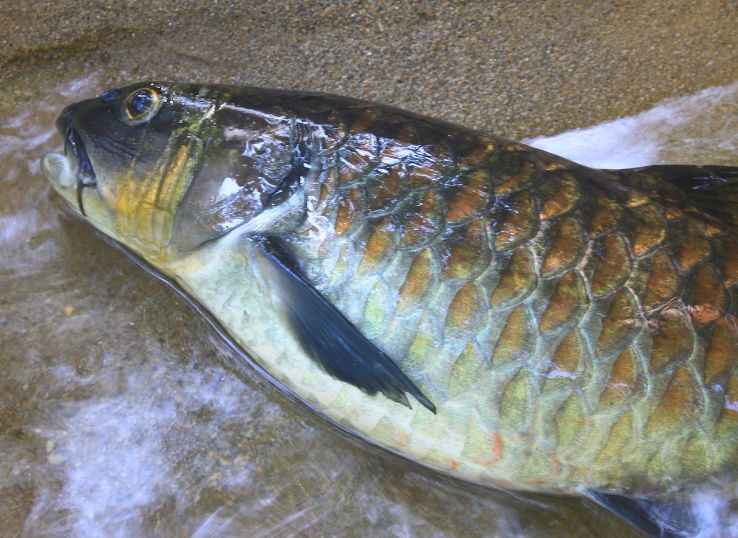Top 11 Endangered Species in Pakistan
Last Updated on June 15, 2022 by Dr. Ali Shahid

Considering the natural beauty, resources, and wildlife in Pakistan, it is no wonder that our country is blessed. Yet, Pakistan is among the top 5 countries vulnerable to climate change and there are a lot of endangered species in Pakistan.
Pakistan has a wide variety of animals. Many exotic animals found in Pakistan are on the verge of extinction because of urbanization, deforestation, and pollution.
IUCN has created a ‘Red List’ of endangered animals with the Climate Change Ministry of Pakistan in an effort to draw attention to the grave situation facing animals across the globe, including more than 50 species that may soon be extinct.
Our team has, however, compiled a list of ten animal species of Pakistan that are critically endangered and deserve attention.
Endangered Species in Pakistan
1.Markhor

As the national animal of Pakistan, the markhor is considered to be one of the most significant animals. Markhor consists of one Persian word “Mar” meaning snake and one Pashto word “khor” meaning eater.
It is native to the high-altitude forests, mountains, and mountains of western and central Asia, where it is often called the screw-horned goat.
In addition to their agile movement and thick winter coats, Pakistani markhors have massive spiral horns ranging from 1.5 meters long on males.
Often located in the highest mountains of the Khyber Pakhtunkhwa province, they are also found in Kohistan, Kalam, and Gilgit Baltistan.
As a result of overhunting for meat and horns in 1994, the Markhor was classified as an endangered species by the IUCN.
At that time, the population had been estimated at under 2,500. The most recent data available from government sources indicate that there are approximately 5,000 to 6,000 wild goats in the area.
2. Snow Leopard

A rare creature in Pakistan’s mountainous areas, which is also sadly on the verge of extinction.
According to the International Union for Conservation of Nature, the population of this species in the wild ranged from 408 to 6,590 individuals in 2003, of which fewer than 2,500 produced offspring.
There are a very limited number of these animals left in the world because of hunting and rapid human expansion.
3. Golden Mahseer

Known as the Golden Mahseer, this is Pakistan’s national fish. Mahseer, or Himalayan Mahseer, as well as Golden Mahseer, are important as the commercial species of food fish and some of the most valuable game fish found in Pakistan.
The species grows to be more than 2 meters long, inhabiting montane areas and flowing rivers, streams, and lakes. There has been a 50crease in the Golden Mahseer’s existence in the last few decades.
Currently, there are only a few populations of small Golden Mahseer remaining in Pakistan, while the larger fishes are found in perennial pools on the northern side of the country.
There is a decline in the number of individuals of this species mainly due to urbanization, overfishing, and environmental changes in the chemical and physical characteristics of the surrounding environment.
4. Long-Billed Vultures

Although the species look evil due to the fact that they eat flesh, these creatures play a significant role in maintaining the ecological balance of Pakistan.
As they feed off of the carcasses of dead animals, they are also a very important component of the Parsi community’s rituals in regard to the disposition of the dead.
A deadly chemical compound is used in livestock feed known as diclofenac sodium, and one of the main effects of this chemical compound is that it kills these vultures at an alarming rate.
Until 2001, Pakistan’s skies were crowded with vultures plying the skies, but now there are no vultures left to be found in the Changa Manga forest, which once had over 1500 vultures living in it.
5. Green Sea Turtle

We must all be shocked to find out that one of the most amazing creatures of the sea, the sea turtle, is unable to flourish due to the horrendous climate we have created by human intervention.
Throughout the world, it is illegal to collect, harm, or kill them; however, the law hasn’t stopped Pakistanis from doing so.
On the black market, the shells and skins of these animals are sold at high prices in exchange for their skins. This is why they have been hunted in large quantities in the past.
6. Himalayan Brown Bear

A number of subspecies of brown bears exist, and one of those subspecies is the Hemacalan brown bear. This species is found in the Himalayas, which include Pakistan, Afghanistan, India, Nepal, as well as China.
According to the IUCN, the Himalayan Brown Bear is the largest mammal in Pakistan and is classified as critically endangered. It is heavily distributed in the Hindukush and Himalayan regions.
In most cases, this endangered species of animal suffers from poaching or hunting so that the animals’ internal organs can be used for medical treatment, and their fur and claws can be used as ornaments, resulting in their extinction.
The shepherds who live in these areas hunt these bears on a regular basis in order to protect their flocks from these ferocious animals.
7. Indus River Dolphin

There are thousands of Indus River dolphins inhabiting the rivers of the lower basin of the Indus River in Pakistan. According to the IUCN, this giant mammal only has a very narrow range and is extremely rare on earth.
There are deep river channels in the Indus River that are home to the Indus River Dolphins. This species is found chiefly in and around the main stem of the Indus River at various locations in Pakistan, from Chashma to Taunsa, Taunsa to Guddu, and Guddu to Sukkur.
Invertebrates and fishes are some of the foods that they eat. With climate change putting Pakistan on the list of the most affected countries, it is no wonder that Indus River Dolphins are severely threatened.
Dams and barrages disrupted their habitats decades ago, which has now led to the drying up of rivers and the displacement of Indus River Dolphins.
8. Marco Polo Sheep

Marco Polo sheep, as its name suggests, is a type of sheep found almost exclusively in the mountainous regions of Central Asia, and it is native to Pakistan.
They are considered valuable in agricultural areas due to their habitat consisting of steep valleys and open areas. Because Marco Polo sheep are a rare species of exotic animal, they tend to be hunted for their hides, meat, as well as horns.
Since 2015, the IUCN has declared them to be endangered. As a result of this, the government is now taking its conservation very seriously.
It should be noted that there is a conservation section in Khunjerab National Park specifically for Marco Polo Sheep, where hunting is prohibited.
9. Asian White-Backed Vulture

There is a term in Pakistan known as Gidh for Asian White-backed Vultures. When the ’90s were in full swing, there were thousands of these vultures in Pakistan.
The vultures in Pakistan are currently critically endangered, with the number of vultures in the country hardly exceeding a hundred.
Their estimated population was 222 in 2011. In Pakistan and other countries, the primary reason why these vultures are becoming extinct is due to the veterinary drug diclofenac, which is transferred to vultures by consuming carcasses.
The use of the painkiller diclofenac was banned in both Pakistan and Nepal in June 2006. It has been reported that Pakistan has salvaged some Asian White-backed Vultures and is soon going to start incubating them artificially.
10. Pallas Cat

There once was a time when the Pallas cat was considered the most beautiful cat in the world, inhabiting the Hindukush Mountains, the Yasin Valley, and the Ishkoman valleys of Pakistan.
Generally speaking, Chitral and Kutram are the two areas where it used to be inhabited and the local dialect of Khowar refers to it as “Runz. It should also be noted that there are a few Pallas cats in Baluchistan as well.
In Pallas, the folds of the fur and the tail are long in order to keep them warm on snowy or frozen ground. It is known that their prey includes a wide range of birds, gerbils, voles, pikas, and even Chukar partridges.
A few years ago, the IUCN declared that Pallas cats are an endangered species because their fur is often hunted for its density.
11.Blackbucks

There is still another endangered species in Pakistan, the blackbuck, which is also known locally as ‘Kaala Hiran. Blackbucks are native to both Pakistan and India.
There has been an important decline in the blackbuck population throughout the world as a result of extensive hunting and urbanization.
As part of an effort to expand the population of this species in Pakistan during the 1970s, a large number of blackbucks from the United States were imported.
Despite the fact that the animal population has increased in Sindh and Punjab, it is still considered endangered by the IUCN because of human and wild animal hunting.
Conservation of endangered species in Pakistan
Here, we will mention a few examples of environmentally friendly projects which have been undertaken in Pakistan in order to preserve species and their habitats.
Pakistan’s environment is subject to a wide range of projects and initiatives aimed at improving the country’s environmental conditions in an effort to help it realize its full potential.
Himalayan Jungle Project (HJP)
As part of the Himalayan Jungle Project (HJP) in Kohistan and Batgram, two districts in Palas Valley, in the northwest region of Pakistan, local communities have been working since 1991.
One of the main goals of the project is to protect one of the most biologically diverse regions of Pakistan.
In keeping with the project’s intent, the project empowered and enabled local residents to establish sustainable, integrated management of the valley’s natural resources while at the same time minimizing any obligation to degrade them.
After the first phase of the HJP project was completed in 1991-1994, European Commission support was provided in the form of an inception year (1994-95) in order to consolidate the work and build-up to the second phase of the project.
Palas Conservation and Development Project (PCDP)
With the support of WWF, the work and approaches of the HJP are improved and expanded with the PCDP. The HJP was fully operational until 1994, then was supported by BirdLife International from 1997 to 2000.
A participatory approach to conservation and development enables local communities to engage in addressing the causes of poverty, as well as preventing natural resource degradation, in ways that ensure biodiversity is protected.
Since 2001, the PCDP has been working on both national and provincial policy issues and has been active for five years.
As a result of participating in the PCDP, Pakistan will also be able to satisfy the obligations it owes to the Convention on Biodiversity Conservation (CBD), to which it has agreed.
Indus Dolphin Project (IDP)
A scientific expedition in 1974 by Giorgio Pilleri discovered that only 150 dolphins lived along 170 km of the Indus River.
This led to the birth of the Indus Dolphin Project in 1977. Government officials designated the area between Sukkur and Guddu barrages as a dolphin reserve after this discovery.
As a consequence, the endemic mammal is still being contained thanks to the strategy which is still being implemented today. Now there are more than 1,000 of them alive.
Marine Turtle Conservation Project
The Sindh Wildlife Department began this project in 1980 in order to protect the turtles that nest on the beaches in Karachi.
It is a regular practice for the staff to collect turtle eggs from the beaches and move them into large cages to keep them safe for future generations.
Counting, weighing, and measuring the hatchlings are then carried out as well as releasing them into the sea.
There have been 430,000 hatchlings released into the sea as part of this project and 2,000 turtle mothers have been tagged as well.
Kirthar National Park
Located in Pakistan’s Protected Areas, this park is a source of many controversies as well as a major tourist attraction. In order to link the Northern Areas of Pakistan with Karachi, it has been decided to build the Indus Highway.
There were plans to build a road that would pass through a park, which would essentially threaten the biodiversity of the park.
In the past, the issue of the construction of the park was exposed by the media, and non-governmental organizations (NGOs) such as the WWF filed lawsuits against it.
As a result of these cases, the government decided to conduct an Environmental Impact Assessment to determine whether the highway could be economically beneficial in comparison to its negatives.

Dr. Ali Shahid is a veterinarian by profession and CEO at provets. He loves to treat animals and has great expertise in veterinary products. Our aim is to provide the best information related to your animal health.





